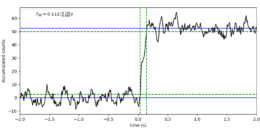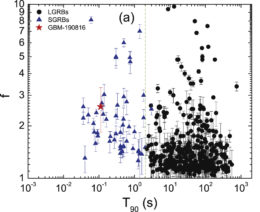On August 16, 2019, both the Fermi Gamma-ray Burst Monitor (GBM) and the Laser Interferometer Gravitational-wave Observatory (LIGO) detected faint blips that didn’t quite register as events. But could these ghost signals actually correspond to the first collision we’ve detected of a black hole with a neutron star?
Neutron Stars and Black Holes: Mix and Match
LIGO’s first detection of gravitational waves was GW150914, the collision of a pair of black holes. In the years since, LIGO has partnered with its European counterpart, Virgo, to make another dozen confirmed detections of binary black holes merging. The collaboration also spotted two instances of binary neutron stars colliding — one of which, GW170817, was accompanied by a short gamma-ray burst and emission spanning the electromagnetic spectrum.

A recent version of the “stellar graveyard”, a plot that shows the masses of the different components of confirmed compact binary mergers. No definite NS–BH mergers have been detected yet. Click to enlarge. [LIGO-Virgo/Northwestern U./Frank Elavsky & Aaron Geller]
Could it be that such an event is actually hidden in the reject data from LIGO/Virgo and Fermi?
A Pair of Intriguing (Non-?)Events
The results from LIGO-Virgo’s third observing run, cut short by the pandemic in March 2020, are still being carefully analyzed by the collaboration. The O3 alert data, however, is publicly available — and a team of scientists have taken advantage of this to do some independent analysis, recently detailed in a publication led by Yi-Si Yang (Nanjing University, China).
Yang and collaborators take note of two faint signals that occurred on August 16, 2020:

The accumulated light curve for GBM-190816 shows the duration of the gamma-ray burst, roughly 0.1 seconds. [Adapted from Yang et al. 2020]
- A subthreshold gravitational-wave event in the LIGO/Virgo data — i.e., an event with a signal-to-noise ratio below 12, the threshold to qualify as a significant candidate.
- A subthreshold gamma-ray burst, GBM-190816, that was picked up by Fermi/GBM just 1.57 seconds after the gravitational-wave event.
If these two signals are both real and related, then GBM-190816 represents a short gamma-ray burst emitted from the merger of two compact objects — and Yang and collaborators’ analysis shows that, with a mass ratio of q ~ 2.26, the system is most likely a neutron-star–black-hole binary. In the simplest explanation, the neutron star was torn apart before the bodies ultimately merged, producing the pair of signals.
Identifying What’s Real
So are these subthreshold events real? We can’t say, yet! The public alerts from LIGO/Virgo only contain a portion of the signal information, so Yang and collaborators had to make a number of assumptions to analyze the event.

The parameters of GBM-190816 (marked by a red star), like the peak-to-background flux ratio vs. duration shown here, are consistent with typical short gamma-ray bursts (blue triangles). [Adapted from Yang et al. 2020]
If confirmed, this event could provide interesting insight into how the light emitted by such a merger escapes and travels to us. Now we just have to wait for the official joint analysis from the LIGO/Virgo/Fermi team!
Citation
“Physical Implications of the Subthreshold GRB GBM-190816 and Its Associated Subthreshold Gravitational-wave Event,” Yi-Si Yang et al 2020 ApJ 899 60. doi:10.3847/1538-4357/ab9ff5

2 Comments
Pingback: Wybuchowe połączenie… Być może – PTMA Kraków
Pingback: Wybuchowe połączenie… Być może – Astronomia Śląska